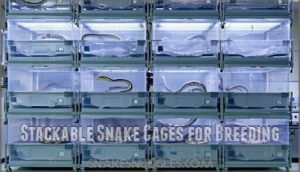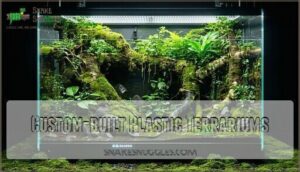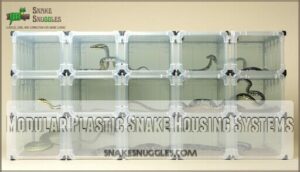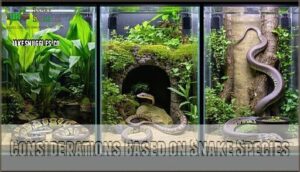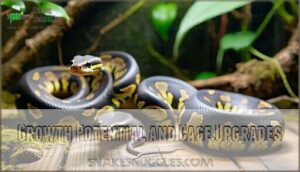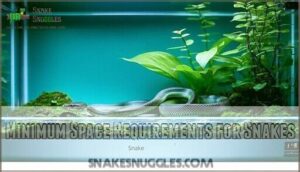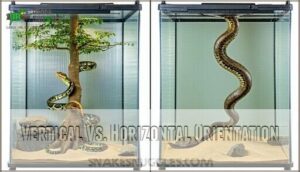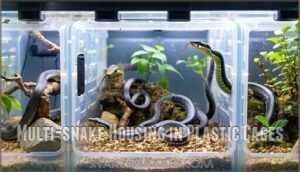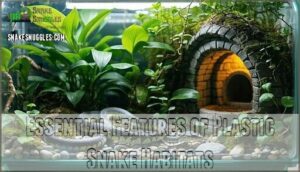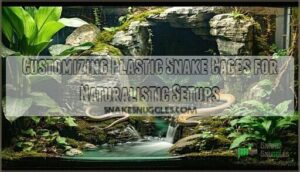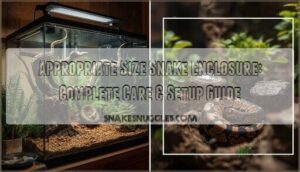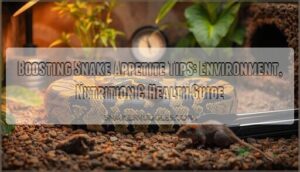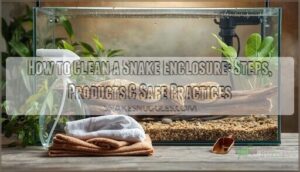This site is supported by our readers. We may earn a commission, at no cost to you, if you purchase through links.
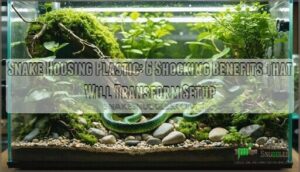
Unlike glass that shatters or wood that warps, plastic enclosures resist scratches, maintain structural integrity, and provide superior moisture control.
They’re lightweight enough to rearrange without breaking your back, yet strong enough to contain even escape artists.
The smooth surfaces make cleaning a breeze – no more scrubbing stubborn stains from porous materials.
Plus, plastic’s excellent insulation properties help maintain stable temperatures your snake craves.
Whether you’re housing a ball python or corn snake, these enclosures deliver the security and hygiene benefits that transform amateur setups into professional-grade habitats.
But choosing the right plastic isn’t just about grabbing any container.
Table Of Contents
- Key Takeaways
- Benefits of Plastic Snake Housing
- Types of Plastic Snake Cages
- Selecting The Right Size Plastic Snake Enclosure
- Essential Features of Plastic Snake Habitats
- Customizing Plastic Snake Cages for Naturalistic Setups
- Maintaining Optimal Conditions in Plastic Snake Housing
- Frequently Asked Questions (FAQs)
- What is the best plastic for snake enclosures?
- Can I keep my snake in a plastic container?
- What to put on the bottom of a snake enclosure?
- Is wood or PVC better for reptile enclosures?
- Can plastic snake cages withstand extreme temperatures?
- How often should plastic snake enclosures be replaced?
- Are plastic snake habitats safe for hatchlings?
- Can plastic cages be used for venomous snakes?
- What plastic types are safest for snake housing?
- How do plastic enclosures affect snake behavior patterns?
- Conclusion
Key Takeaways
- You’ll get unmatched durability – Plastic enclosures resist cracking, warping, and scratches that plague glass or wood alternatives, with high-quality HDPE lasting over 20 years with minimal maintenance.
- You’ll save time on cleaning – Smooth plastic surfaces make sanitization effortless with simple three-step processes (daily wipes, weekly soap cleaning, monthly disinfection) compared to scrubbing porous materials.
- You’ll enjoy practical advantages – Lightweight construction lets you move enclosures single-handedly, while stackable designs maximize your space and reduce costs by 30-50% compared to glass alternatives.
- You’ll maintain better environmental control – Plastic’s excellent moisture resistance and insulation properties help you achieve stable temperatures and humidity levels your snake needs for optimal health.
Benefits of Plastic Snake Housing
You’ll discover that plastic snake housing offers practical advantages that make reptile care more manageable and efficient.
These enclosures provide solutions for common husbandry challenges while maintaining the health and safety of your snakes.
Durability and Longevity of Plastic Enclosures
You’ll discover that plastic snake enclosures consistently outperform other materials in durability tests.
High-density polyethylene (HDPE) and polypropylene resist cracking, warping, and punctures that typically plague glass or wood alternatives. These durable reptile habitats withstand decades of use without material degradation.
HDPE and polypropylene turn snake keeping into a set-it-and-forget-it hobby that lasts decades.
- Material strength exceeds expectations with HDPE handling temperatures up to 248°F
- Crack resistance prevents structural failure from snake behaviors like burrowing
- UV damage protection keeps enclosures looking new for years
- Longevity tests show plastic snake enclosures lasting over 20 years with minimal wear
The choice of enclosure material is vital, considering factors like reptile habitat needs to guarantee the well-being of the snakes.
Easy Cleaning and Maintenance
Three simple steps transform plastic snake enclosures into spotless sanctuaries.
Daily sanitizing with reptile-safe wipes prevents bacterial buildup while maintaining humidity control.
Weekly deep cleaning using mild soap eliminates stubborn residue from durable reptile habitats.
Monthly disinfection methods guarantee complete pathogen elimination.
Plastic snake enclosures resist staining and scratching, making reptile enclosure maintenance effortless.
Smart cleaning tips include removing substrate before washing and air-drying thoroughly.
Effective odor management involves baking soda treatments between cleanings.
These easy to clean surfaces save hours compared to traditional materials, giving you more time with your serpentine companions while maintaining pristine snake enclosure cleaning standards and following simple steps.
Lightweight and Stackable Designs
Lightweight reptile enclosures offer unmatched portability and space-saving solutions for your snake collection.
These stackable design marvels transform cramped spaces into organized breeding facilities.
- Portable Enclosures – Move single-handedly during cleaning or relocations
- Stackable Racks – Create vertical breeding towers that maximize floor space
- Modular Designs – Expand your collection without reorganizing entire setups
- Compact Housing – Fit more snakes in smaller rooms than traditional glass terrariums
Moisture Resistance and Humidity Control
Plastic snake enclosures excel at moisture resistance and humidity control.
These materials create effective moisture barriers that prevent water damage while maintaining ideal humidity levels.
Air exchange systems and evaporative control features help regulate moisture without compromising your snake’s health.
Humidity sensors work seamlessly with plastic surfaces, giving you precise water management.
Reptile enclosure ventilation becomes effortless with proper humidity management systems integrated into plastic designs.
This integration ensures a healthy environment for your snake, making plastic enclosures a preferred choice for many reptile owners.
Cost-effectiveness Compared to Other Materials
Why spend more when plastic snake enclosures deliver exceptional value? Material costs for plastic remain substantially lower than glass or wood alternatives. Price comparison reveals plastic offers superior economic benefits through reduced replacement frequency and minimal maintenance requirements.
Budget analysis shows these durable enclosures provide substantial resource savings over time.
Consider these cost-effective advantages:
- Lower initial investment – plastic reptile cages cost 30-50% less than glass
- Reduced shipping expenses – lightweight design cuts transportation costs dramatically
- Minimal repair needs – easy to clean surfaces resist damage better than alternatives
Plastic snake housing transforms your setup economics. These enclosures withstand daily wear while maintaining structural integrity. You’ll avoid frequent replacements that drain budgets with glass or wooden options.
The lightweight construction means lower shipping costs when expanding your collection. Think of plastic as your financial safety net – it protects both your snakes and your wallet simultaneously.
Types of Plastic Snake Cages
You’ll find several distinct types of plastic snake cages designed for different needs and budgets. Each type offers unique features that make them suitable for specific situations and snake species.
Vision Cages and Their Features
Vision Cages represent the gold standard in plastic snake enclosures, engineered with single-piece molded HDPE construction that outlasts cheaper alternatives.
These reptile plastic cages feature tempered glass doors sliding on anodized aluminum tracks, ensuring durability and escape prevention. Perforated aluminum venting systems maintain proper airflow while retaining humidity.
Available cage materials include classic gray and black granite finishes. Heat options integrate seamlessly into rack designs, with Vision Tubs accommodating various snake species.
From compact 20-gallon models to spacious 70-gallon units, these plastic reptile enclosures deliver professional-grade performance for serious keepers. The quality of Vision Cages can be further researched through online reptile supply sources.
Stackable Snake Cages for Breeding
With stackable designs revolutionizing breeding operations, you’ll maximize your facility’s potential without expanding your footprint.
These plastic snake cages create independent climate zones with dedicated ventilation systems and humidity control for each tier. Secure locking mechanisms guarantee cage security while promoting healthy snake behavior.
Breeding success soars when you can monitor multiple enclosures efficiently. Snake breeding racks transform chaotic collections into organized, professional setups that save space and boost productivity.
By following proper stacking guide techniques, breeders can optimize their space and create a thriving environment for their snakes.
PVC Snake Enclosures for Budget Options
Budget-conscious reptile keepers can breathe easy with PVC snake enclosures. These budget options deliver solid snake safety without breaking the bank.
PVC materials offer decent plastic durability for species like ball pythons and corn snakes. While PVC construction won’t match premium plastic snake cages, these reptile plastic housing solutions work well for beginners.
PVC reptile enclosures feature simple enclosure design that’s easy to clean. Plastic snake enclosures provide adequate ventilation and security for most species.
Custom-built Plastic Terrariums
Custom-built plastic terrariums offer complete control over your snake’s environment. You become the architect, designing every detail to match your serpent’s specific needs and behaviors.
Key advantages of custom plastic terrariums:
- Terrarium Design flexibility – Create unique layouts for arboreal or terrestrial species
- Plastic Materials selection – Choose food-grade, UV-resistant materials for durability
- Custom Features integration – Add specialized hiding spots, climbing structures, or feeding areas
- Terrarium Lighting compatibility – Design heat-resistant areas for specific lamp installations
- Advanced Ventilation systems – Engineer airflow patterns for ideal humidity control
Building custom-built terrariums requires careful planning and quality plastic materials. Consider your snake’s adult size, natural habitat, and behavioral needs when designing. While DIY plastic snake terrariums demand time and skill, they deliver unmatched customization for serious reptile keepers.
Modular Plastic Snake Housing Systems
Modular plastic snake housing systems revolutionize reptile keeping with their expandable design. You can add or remove housing modules as your snake grows, creating the perfect fit every time.
These PVC enclosures offer unmatched flexibility for breeding programs or growing collections. Plastic materials provide durability while ventilation systems guarantee proper airflow throughout each module.
| Feature | Benefit | Snake Species |
|---|---|---|
| Expandable Design | Grows with snake | Ball pythons, boas |
| Stackable Modules | Space efficiency | Corn snakes, kingsnakes |
| Quick Assembly | Easy setup | All species |
| Interchangeable Parts | Custom configurations | Pythons, colubrids |
| Cost-Effective | Budget-friendly expansion | Beginner collections |
Snake safety remains paramount with secure connections between modules. Modular systems eliminate guesswork in snake plastic housing, giving you complete control over your reptile housing solutions.
Selecting The Right Size Plastic Snake Enclosure
You’ll need to match your plastic enclosure to your snake’s specific needs and adult size potential.
Consider your snake’s species, natural behavior, and how much they’ll grow before choosing dimensions that’ll serve them for years.
Considerations Based on Snake Species
When choosing plastic snake cages, nail down your species research first.
Different snake species have vastly different environmental needs and behaviors.
Ball pythons need higher humidity than corn snakes, while arboreal species require vertical space for climbing.
Consider these species-specific factors:
- Size requirements – Measure your snake’s full length for minimum enclosure dimensions
- Habitat design needs – Terrestrial species need floor space; arboreal species need height
- Environmental parameters – Tropical species need higher humidity than desert species
Your snake’s natural behavior patterns determine the ideal reptile housing setup.
Species compatibility matters if you’re housing multiple snakes together.
Understanding the snake tank size is essential for creating a suitable environment for your pet snake.
Growth Potential and Cage Upgrades
Your snake won’t stay small forever. Ball pythons grow from 10-17 inches to 3-5 feet. Corn snakes reach 4-6 feet from 8-12 inch hatchlings. Boa constrictors can hit 6-10 feet from their 14-22 inch start.
Planning for adult size prevents costly habitat expansion later. Plastic snake cages offer upgrade options that match species needs perfectly.
Minimum Space Requirements for Snakes
Without proper dimensions in your snake housing setup, you’re setting yourself up for stressed reptiles and poor health outcomes.
Snake Space Needs demand your enclosure be at least as long as your snake, with sufficient width for complete body curls.
Habitat Depth matters too – terrestrial species need floor space while others require vertical room.
Minimum space requirements aren’t suggestions; they’re essential for proper behavior and wellbeing in plastic snake cages.
Vertical Vs. Horizontal Orientation
Your snake’s lifestyle determines whether you need vertical reptile cages or horizontal space efficiency.
Arboreal species like green tree pythons thrive in tall plastic snake cages with climbing structures. Terrestrial snakes need wide reptile enclosures for ground movement. Semi-arboreal species benefit from balanced habitat design combining both orientations.
Orientation Tips for Snake Behavior:
- Arboreal hunters – Tall snake plastic tanks maximize natural climbing instincts
- Ground dwellers – Wide snake housing prevents stress from cramped quarters
- Mixed lifestyles – Flexible designs accommodate changing behavioral needs
- Burrowing species – Floor space trumps height for natural digging behaviors
Multi-snake Housing in Plastic Cages
Housing multiple snakes together isn’t rocket science, but snake compatibility matters more than you’d think.
You can’t just throw different species into plastic terrariums and hope for the best. Group housing works best with similar-sized, non-aggressive species in spacious reptile enclosures.
Cage division helps separate territorial snakes when needed. Proper ventilation becomes critical with multisnake housing since waste accumulates faster in plastic snake containers.
Essential Features of Plastic Snake Habitats
When you’re selecting plastic snake housing, specific features make the difference between a basic cage and a proper habitat.
The right ventilation, security, and heating compatibility guarantee your snake stays healthy and secure while making your maintenance routine much easier.
Ventilation Systems and Air Circulation
When your snake’s enclosure lacks proper Air Flow, respiratory problems develop quickly.
Ventilation Systems create essential Air Quality by preventing stagnant air and harmful bacteria buildup.
Position vents high on warm sides and low on cool areas to establish natural Circulation Patterns.
Breathable Materials like mesh strips or adjustable covers control airflow without losing humidity.
This air circulation supports healthy temperature regulation while maintaining proper humidity control for ideal reptile enclosure ventilation.
Secure Locking Mechanisms
Before bedtime, your snake shouldn’t become an escape artist.
Secure locking mechanisms on plastic snake cages prevent midnight adventures. Quality latch designs feature dual-action locks that require two movements to open.
Safety features include tamper-proof systems and escape prevention technology.
Secure doors with reinforced locking systems guarantee your reptile stays put while providing easy access for maintenance.
Heat-resistant Plastic for Lamp Installations
Heat-resistant plastic keeps your snake safe from lamp hazards.
Quality plastic terrariums use thermal resistance technology and fire protection features. Look for PVC materials with built-in heat shields around lamp mounting areas.
These reptile enclosure materials prevent melting and warping under high temperatures. Your plastic snake cages need proper lamp safety zones to avoid dangerous hotspots that could harm your pet.
Proper snake habitat construction is essential for creating a safe and healthy environment for your snake, with a focus on heat protection.
Substrate Compatibility With Plastic Bottoms
Your plastic snake cages need the right substrate to keep your reptile healthy and comfortable.
Substrate compatibility with plastic bottoms affects everything from humidity management to cleaning ease. Smart substrate choices prevent moisture problems and maintain proper conditions in your plastic terrariums.
Consider these substrate compatibility factors for reptile enclosure materials:
- Coconut fiber and cypress mulch – excellent moisture control without damaging plastic
- Aspen shavings – safe, absorbent, and easy to replace in plastic liners
- Paper towels – budget-friendly bottom materials for simple cleaning
- Sphagnum moss – boosts humidity retention when mixed with other substrates
- Avoid cedar, pine, or crushed walnut – these can damage plastic or harm your snake
Substrate safety starts with choosing materials that won’t scratch or stain your plastic snake habitat while supporting your snake’s natural behaviors. Reptile owners should research reptile substrate options carefully to guarantee the best environment for their pets.
Integration of Hide Boxes and Climbing Structures
Beyond choosing the right substrate, you’ll need to create a multi-dimensional environment that mimics your snake’s natural world.
Hide Box Design and Climbing Structures aren’t just decorative elements—they’re essential Enrichment Tools that reduce stress and promote natural behaviors.
Your snake habitat requires strategic placement of these Habitat Features to maximize comfort and security.
The placement should consider the snake’s need for security, thermoregulation, and opportunities for exercise and exploration.
| Structure Type | Primary Function |
|---|---|
| Hide Boxes | Security and thermoregulation |
| Climbing Branches | Exercise and exploration |
| Cork Bark Tubes | Vertical movement opportunities |
| Rock Ledges | Basking and observation points |
Plastic snake habitats excel at supporting these snake plastic shelters because they’re easy to clean and won’t warp from moisture.
Your reptile enclosure design should include Snake Hides on both warm and cool sides, plus snake enclosure accessories that encourage natural movement patterns.
This design will help create a comfortable and secure environment for your snake, promoting its overall well-being and natural behaviors.
Customizing Plastic Snake Cages for Naturalistic Setups
You’ll transform your plastic snake cage into a living ecosystem that mirrors your snake’s natural habitat.
These customization techniques create environments that promote natural behaviors while maintaining the practical benefits of plastic housing.
Incorporating Live Plants in Plastic Enclosures
Many snake keepers discover that live plants transform their plastic snake housing into thriving ecosystems.
Plant selection matters—choose non-toxic species like pothos or spider plants for your naturalistic setups.
Use organic soil choices and establish proper watering systems to prevent root rot.
Plant care requires weekly monitoring, while strategic habitat design prevents damage from snake movement.
Your reptile enclosure design benefits from improved air quality and natural humidity regulation.
Creating Elevation With Plastic Shelves
Your plastic snake housing gains serious vertical real estate with thoughtfully designed shelves.
These elevated platforms transform flat snake tanks into multi-level territories that satisfy your reptile’s natural climbing instincts.
- Shelf Material Safety – Choose food-grade plastic with smooth edges and non-toxic finishes
- Shelf Weight Capacity – Calculate load limits based on your snake’s adult weight plus accessories
- Shelf Installation Methods – Use secure mounting brackets that won’t shift during snake movement
- Shelf Texture Considerations – Add grip strips or textured surfaces for confident snake navigation
Your plastic shelving creates dynamic snake shelter zones while maintaining the structural integrity of your habitat system.
Consider how climbing encourages exercise for your snake.
Water Features Compatible With Plastic Habitats
Adding water features to your plastic snake housing brings your snake enclosure closer to a natural habitat.
When setting up a water source, prioritize material safety and guarantee strong humidity control for your species.
Explore filtration options to keep things fresh and reduce cleaning frequency.
Monitor snake interaction with the water area—some love to soak, others may tread lightly.
Regular maintenance is key: a steady cleaning routine prevents unwanted bacteria and supports a healthier snake habitat.
UV-resistant Plastics for Outdoor Setups
Outdoor snake housing demands UV-resistant plastics to prevent material degradation and extend lifespan.
These specialized plastic enclosures protect against weather damage while maintaining structural integrity. Your snake habitat investment deserves this protection.
Consider these outdoor durability factors:
- Weather Resistance: UV-resistant plastics withstand temperature fluctuations and moisture without cracking
- Material Degradation Prevention: Special additives block harmful UV rays that cause brittleness
- Lifespan Extension: Quality materials last 10-15 years versus 3-5 for standard plastics
- Cost Analysis: Higher upfront investment saves money through reduced replacement needs
Choose plastic snake habitats specifically rated for outdoor use to guarantee your snake housing performs reliably.
Maintaining Optimal Conditions in Plastic Snake Housing
Creating the perfect environment in your plastic snake enclosure requires careful attention to temperature, humidity, and lighting systems.
You’ll discover that maintaining these conditions becomes straightforward once you understand the unique properties of plastic housing materials, which is crucial for creating an ideal environment.
Temperature Regulation in Plastic Enclosures
Temperature regulation in plastic enclosures requires strategic heat source placement and proper thermostat calibration. Plastic’s poor insulation makes maintaining ambient temperature challenging, but targeted heating creates effective thermal gradients for species requirements.
Optimal snake comfort relies on proper heating.
- Belly heat systems: Install heat mats with 3/16" recess spacing for safe, even heat distribution underneath substrate areas.
- Back heat options: Mount 12-inch heating panels on rear walls for basking spots while maintaining temperature control systems.
- Insulation strategies: Use multiple heat sources with individual thermostats to create proper temperature zones throughout the enclosure.
Humidity Control Methods for Plastic Cages
Controlling humidity in plastic cages requires strategic misting systems and proper ventilation adjustments.
Water bowls placed on the warm side boost evaporation, while substrate moisture from coconut coir or cypress mulch maintains humidity retention.
Humidifiers provide consistent humidity regulation for larger setups.
| Method | Humidity Range |
|---|---|
| Manual Misting | 90-100% (temporary) |
| Automated Systems | 50-70% (stable) |
| Large Water Bowls | 60-80% (gradual) |
| Humid Hides | 80-95% (localized) |
Humidity control systems need daily monitoring with hygrometers.
Humidity management techniques include partially covering screen tops and using damp moss in hide boxes for humidity control.
Lighting Options for Plastic Snake Habitats
Plastic snake habitats offer flexible lighting options that adapt to your reptile’s needs.
UVB lighting supports calcium absorption and overall health, while heat lamps create perfect basking zones for temperature control.
LED options provide energy-efficient illumination with programmable light cycles that mimic natural day-night patterns.
Many owners buy reptile UVB bulbs online for convenience.
Always consider safety concerns when installing fixtures in your reptile habitat – make certain proper heat distribution and secure mounting to prevent accidents in your snake habitat.
Substrate Choices for Plastic-bottomed Cages
Your snake habitat deserves the right foundation.
Smart substrate choices for plastic snake housing directly impact humidity retention and cleaning ease. The right material transforms your plastic tubs into comfortable, safe environments.
- Aspen shavings – Perfect for burrowing species, cost-effective with excellent snake safety
- Coconut fiber – Superior humidity retention for tropical species requiring higher moisture levels
- Newspaper – Budget-friendly option offering maximum cleaning ease and health monitoring visibility
- Reptile carpet – Reusable naturalistic substrates that prevent impaction while maintaining proper snake care standards
Cleaning and Disinfecting Plastic Snake Enclosures
With proper substrate selection sorted, keeping your snake plastic containers spotless becomes your next priority.
Daily spot cleaning removes waste immediately, while weekly deep cleaning prevents buildup. Monthly disinfecting procedures eliminate harmful bacteria completely.
| Cleaning Task | Frequency |
|---|---|
| Spot cleaning waste | Daily |
| Deep scrub surfaces | Weekly |
| Full disinfection | Monthly |
Safe disinfectants designed for reptile cage cleaning won’t harm your snake. Focus on odor removal and mold prevention by targeting corners where moisture accumulates.
Thorough residue removal after disinfecting plastic enclosures guarantees no chemical traces remain.
Frequently Asked Questions (FAQs)
What is the best plastic for snake enclosures?
High-density polyethylene (HDPE) stands out as the top choice for snake enclosures.
You’ll find it’s durable, easy to clean, and resists cracking.
It maintains humidity well while being lightweight and stackable for growing collections.
Can I keep my snake in a plastic container?
You can temporarily house your snake in a plastic container, but it’s not ideal long-term.
Choose food-grade plastic with proper ventilation, secure lids, and adequate space for your snake’s size and species.
What to put on the bottom of a snake enclosure?
Like setting the stage for a perfect performance, you’ll want substrate that’s both functional and safe.
Choose aspen shavings, cypress mulch, or paper towels for easy cleaning and natural behavior support.
Is wood or PVC better for reptile enclosures?
If you want easy cleaning and moisture control, go with PVC.
Wood holds heat better but can warp or mold.
For most snakes, PVC cages win out—think fortress with a rinse-and-go shield against humidity drama.
Can plastic snake cages withstand extreme temperatures?
Plastic snake cages handle moderate temperature ranges well, but extreme heat can warp or damage them. You’ll need proper ventilation and heat-resistant materials for high-temperature setups to prevent melting.
How often should plastic snake enclosures be replaced?
Forever’s a myth in the context of replacement schedules.
You’ll typically replace plastic snake enclosures every 5-10 years, depending on wear, scratches, and structural integrity.
Regular inspections help determine when it’s time for an upgrade.
Are plastic snake habitats safe for hatchlings?
Yes, plastic snake habitats are safe for hatchlings when properly designed.
They’re durable, easy to clean, and maintain humidity well.
However, make certain to have adequate ventilation and avoid sharp edges from scratches.
Can plastic cages be used for venomous snakes?
Venomous snakes require specialized secure enclosures with reinforced locks, escape-proof design, and proper ventilation.
You’ll need additional safety features like viewing windows and emergency access ports that standard plastic cages typically lack for handling hot species safely.
What plastic types are safest for snake housing?
Finding the right plastic is like choosing armor for your snake’s sanctuary.
High-density polyethylene (HDPE) stands as the gold standard, offering durability without toxic chemical leaching.
You’ll also find polypropylene and ABS plastic work well for safe housing, making them viable alternatives to HDPE, which is considered the gold standard for its durability and safety.
How do plastic enclosures affect snake behavior patterns?
Plastic enclosures can reduce your snake’s stress through customizable hide spots and climbing structures, but poor ventilation might trigger respiratory issues while scratched surfaces create behavioral anxiety from compromised security.
Conclusion
Apparently, your snake doesn’t care about your aesthetics preferences – it just wants a secure, functional home that won’t break your budget or your back.
Snake housing plastic delivers exactly that with its superior durability, effortless maintenance, and excellent environmental control.
You’ll find these enclosures outperform traditional materials while providing the reliability your serpent needs.
Choose plastic housing that matches your snake’s specific requirements, and you’ll create a professional-grade habitat that benefits both keeper and snake.
- https://www.visionproducts.us/blog/reptile-enclosure-materials/
- https://www.pbspettravel.co.uk/blog/snake-vivariums-what-are-the-options/
- https://www.youtube.com/watch?v=hM15VUjqOWE
- https://ourreptileforum.com/community/threads/why-dont-more-people-use-hdpe-cages-vs-pvc-cages.19598/page-2
- https://www.junglebobsreptileworld.com/collections/plastic-pet-terrariums-for-sale-jungle-bobs-reptile-world


